Biodiversity and Forestry: The Canada Lynx as Umbrella Species
NEFF's Exemplary Forestry protects biodiversity on managed lands, and the…

For many years to come, 10 fascinating songbird species that migrate along the Atlantic flyway are going to be part of the NEFF community. A flyway is a migratory superhighway that birds travel year after year, and Maine forests—including NEFF properties—serve as a crucial migratory resting spot for these 10 species as they journey up and down the flyway.
Rediscover why these birds are joining the NEFF team, as it were, and then learn about the birds themselves: the American Redstart, Bay-breasted Warbler, Black-throated Blue Warbler, Canada Warbler, Chestnut-sided Warbler, Eastern Wood-Pewee, Olive-sided Flycatcher, Rusty Blackbird, Veery and Wood Thrush.
In 2019, NEFF was approached to take ownership of two Downeast Maine properties explicitly so we could practice Exemplary Forestry on them to benefit migratory songbirds in keeping with the Maine Wind Energy Act.
After careful consideration, NEFF decided to cap off our Downeast Woods and Wildlife conservation project by accepting these lands in 2020: a 2,690-acre parcel along Holmes Stream in Washington County and a 3,100-acre parcel near Egypt Bay in Hancock County.
Habitat and biodiversity experts crafted Songbird Habitat Management Plans for the forestlands that called for management activities to create and improve large habitat blocks; NEFF has contracted a Maine-based forester to evaluate the properties and then fold the Songbird Habitat Management Plans into an overarching Forest Management Plan based in Exemplary Forestry.
Through management of what we now call Holmes Stream and Frenchman Bay Community Forests, NEFF’s goal is to create and support stopover and nesting habitat for migratory songbirds within the framework of Exemplary Forestry standards, with a particular emphasis on the needs of the Songbird Habitat Management Plans’ ten priority species—the true stars of this article.
The last time NEFF wrote about its goals for these properties in any detail, we weren’t able to spend much time on the bird species themselves. We’ll be checking in on the implementation of Holmes Stream and Frenchman Bay’s specialty management plan in the future, but for now, on to the birds.
All 10 priority songbird species have been identified at a state or international level as at-risk to varying degrees, and have been observed on or near Holmes Stream Community Forest, Frenchman Bay Community Forest, or both properties.
Direct quotes and some general information in this section come from Cornell University’s allaboutbirds.com. This section also draws on information from these texts by way of NEFF’s Songbird Habitat Management Plans: M.L. Avery’s Rusty Blackbird entry in The Birds of North America, version 2.0; R.M. DeGraaf and M. Yamasaki’s New England Wildlife: Habitat, Natural History, and Distribution; R. Dettmers’ “A Blueprint for the Design and Delivery of Bird Conservation in the Atlantic Northern Forest;” and Maine Audubon’s Forestry for Maine Birds: A Guidebook for Foresters Managing Woodlots “With Birds in Mind.”
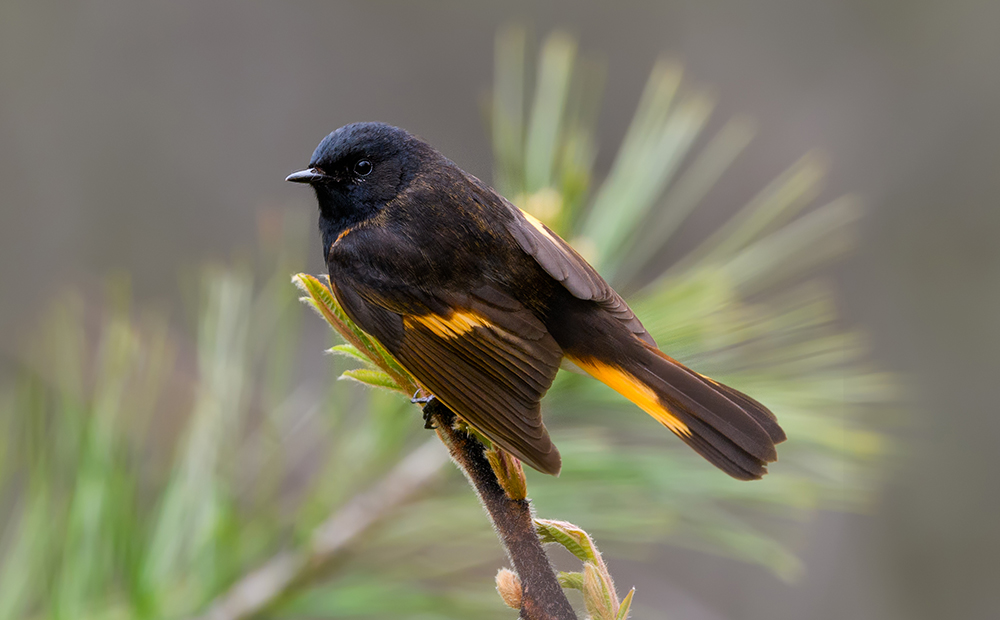
American Redstart, photo by Judd Patterson
Adult male and female American Redstarts have colored patches on their sides, wings and tail in the same places, but where male birds have bright orange patches, female birds have yellow. Male birds are otherwise mostly black, while females have a gray head and an olive back. Their song consists of variable high notes, ending with a down-slurred note.
American Redstarts’ bright colors serve a purpose when hunting insects: they use their long, agile tails to startle prey by flashing color patches at them.
Conservation Status: Species of Greatest Conservation Need in Maine, High Priority
Habitat: American Redstarts breed in early successional hardwood forests; this means young forests of about 1-20 years in age. Their specific preferred conditions include moist forest edge habitat, partially open canopy cover and a thick understory of saplings.
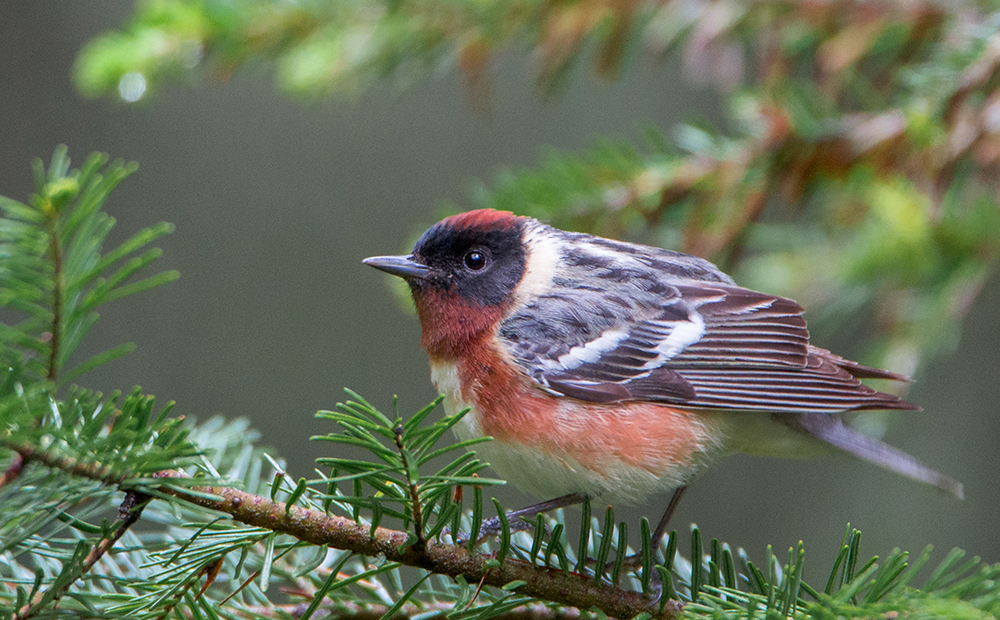
Bay-breasted Warbler, photo by Judd Patterson
Both males and females of this long-winged warbler have striking white wingbars. During the summer breeding season, the males are “highlighted with rich red-brown and creamy buff,” and females maintain similar patterning in more subtle colors. Their song is a fast and high-pitched seetzy, seetzy, seetzy.
Conservation Status
Habitat: Bay-breasted Warblers breed in boreal forests and mature northern coniferous or mixed forests. While they tend to prefer older forest stands, they may still breed in younger mixed-wood stands during spruce budworm outbreaks, as they are “voracious predators” of spruce budworms.
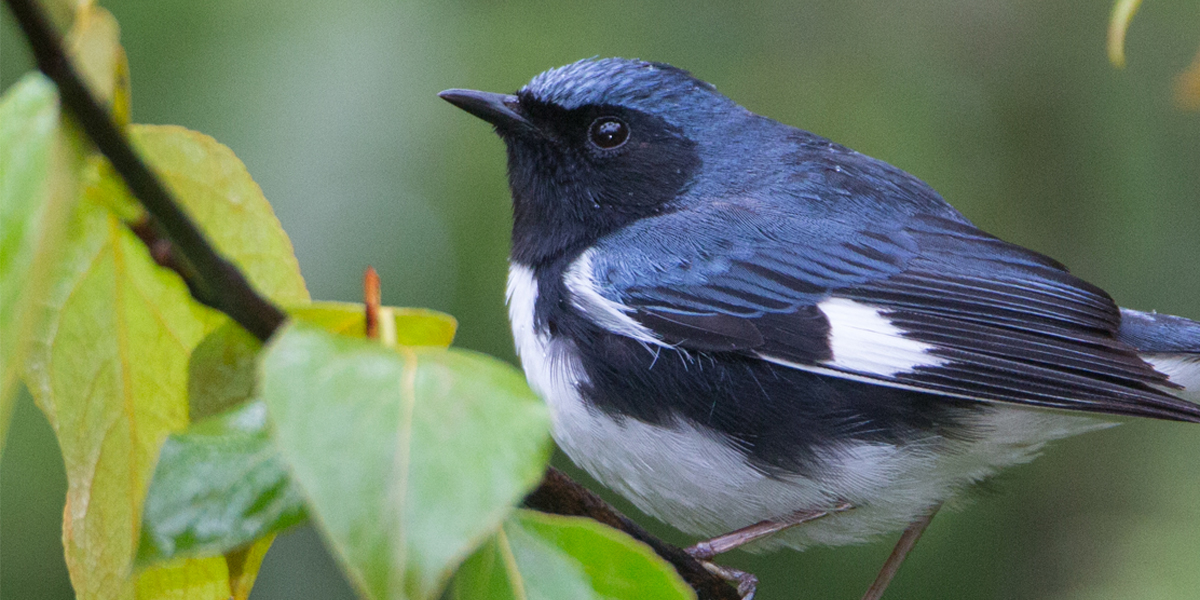
Black-throated Blue Warbler, photo by Judd Patterson
This large and uniquely colored warbler is so striking that even long-time birders can’t help but feel pleased to see one. Breeding males have a black face and dark blue head and body. The females are most often described as “grayish” and “olive,” and males and females share a distinguishing white square on their wings. Their song is an assertive please-please-please squeeeeze.
Conservation Status: Species of Greatest Conservation Need in Maine, Moderate Priority
Habitat: Black-throated Blue Warblers generally and during breeding prefer large, contiguous tracts of mature forest with a dense understory of shrubs and small saplings where they forage, as well as a high canopy that provides 50-80 percent cover.
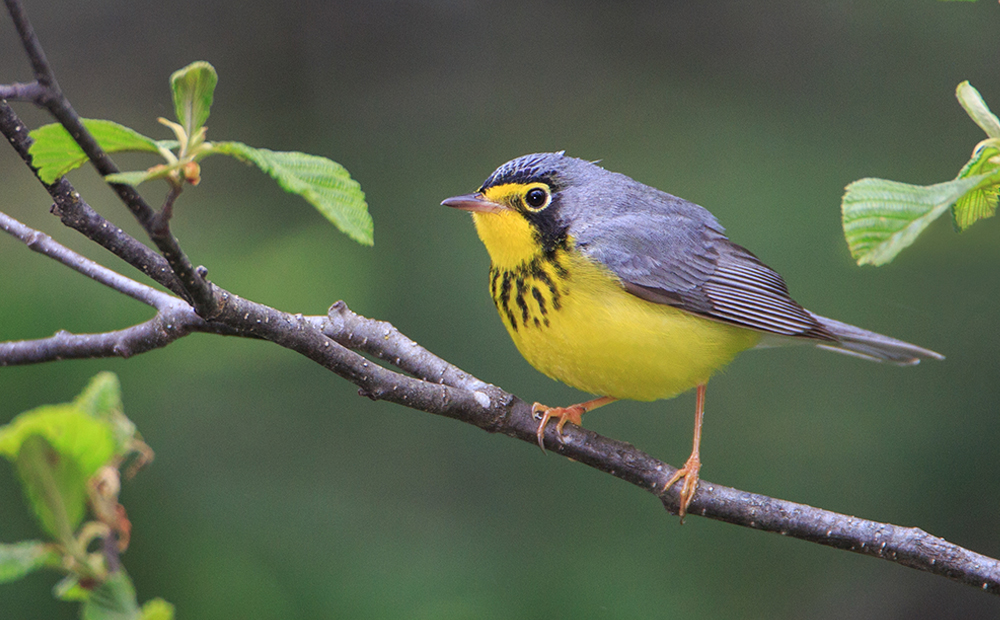
Canada Warbler, photo by Judd Patterson
As one of the last woodland songbirds to arrive in Maine and Canada during late spring, Canada Warblers only stay on the breeding grounds for a brief two months. Their song is a musical warble that starts with an emphatic chip note.
Conservation Status:
Habitat: Canada Warblers use moist hardwood and mixed-wood forests with dense understories. They are particularly interested in damp places such as swamps, riparian areas, bogs, upland forests with mossy hummocks, and dense undergrowth in cool, moist mature forests.
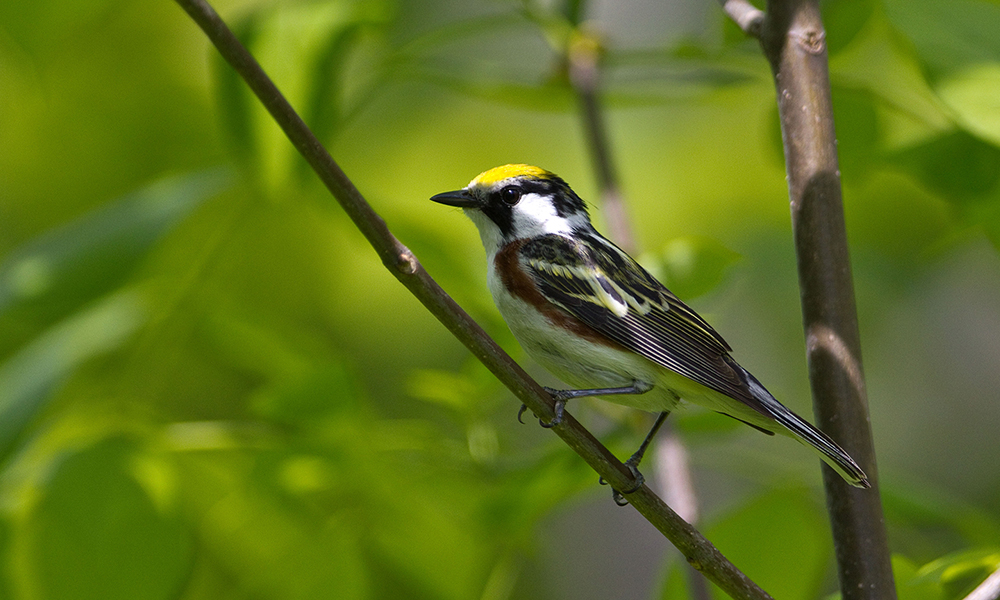
Chestnut-sided Warbler
One of the male Chestnut-sided Warbler’s songs sounds like pleased, pleased, pleased to meetcha! Breeding males have a yellow crown, black around the eyes, white cheeks, and bold chestnut strips down their sides. Breeding females have similar patterns to males, but have light grey cheeks and are paler with less streaking on the back.
Conservation Status: Species of Greatest Conservation Need in Maine, High Priority
Habitat: Chestnut-sided Warblers are true early successional specialists, and are usually found in young hardwood forests with dense thickets and saplings, and an open canopy.
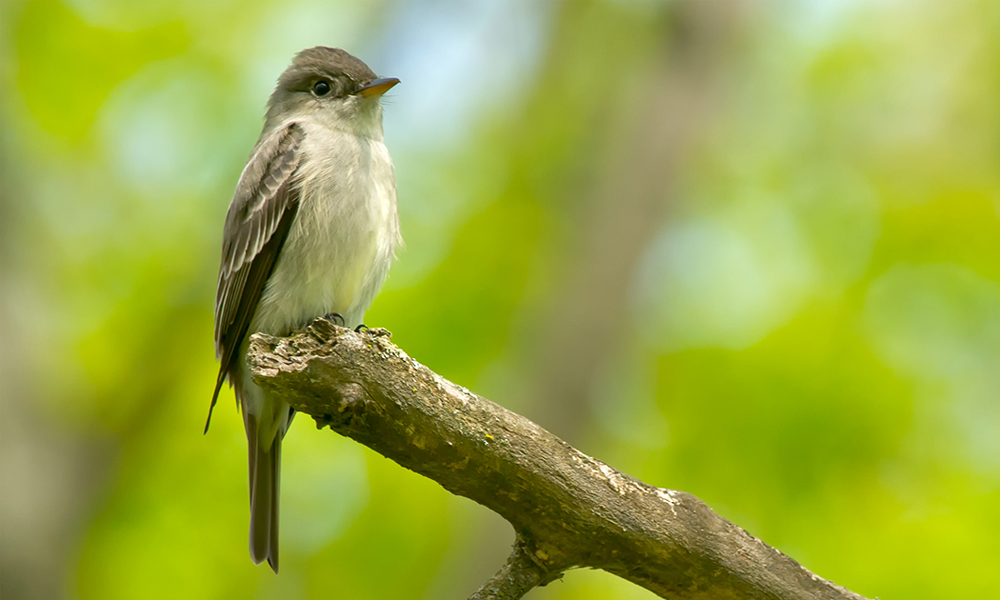
Eastern Wood Pewee
The Eastern Wood-Pewee may not be as flashy as some of the other birds in this article, but that crest gives it a jaunty look, and its pee-a-wee! call is common along the eastern seaboard and may make for a fond summertime memory.
Conservation Status:
Habitat: The Eastern Wood-Pewee prefers open, hardwood or mixed forests, and is particularly associated with small gaps, openings and edges within hardwood forests with moderate canopy cover and an open midstory.
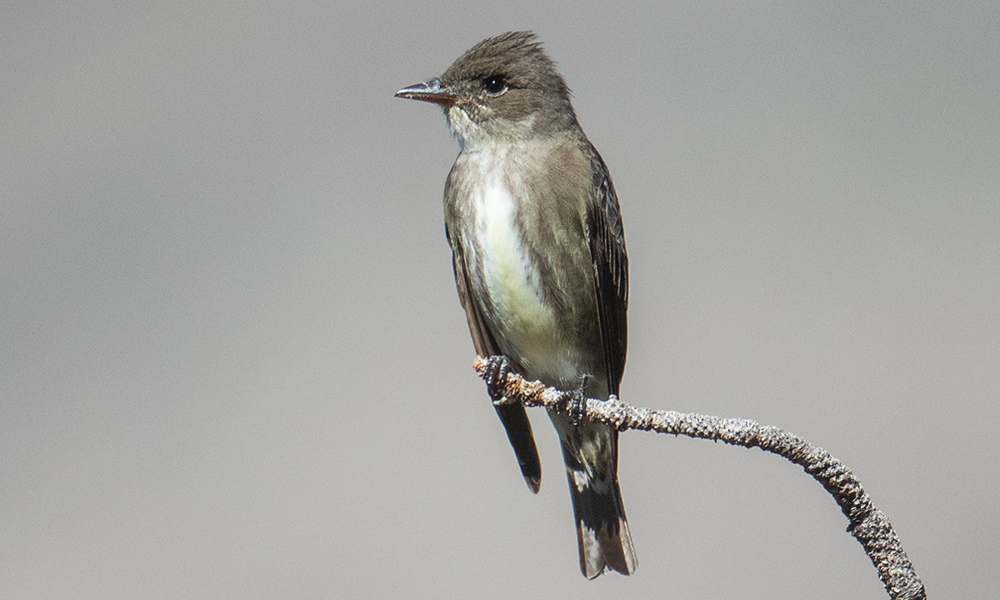
Olive-sided Flycatcher, photo by Judd Patterson
Flycatchers tend to have drab coloring, but Olive-sided Flycatchers set themselves apart by being larger and stronger than other flycatchers, and having dark waistcoat-like markings on their sides. Their song is a recognizable quick, three beers with a quiet quick and an accented second syllable.
Conservation Status:
Habitat: Olive-sided Flycatchers use bog and spruce-fir habitats with tall, open stands; forests that have prominent perch locations; and forest edges.
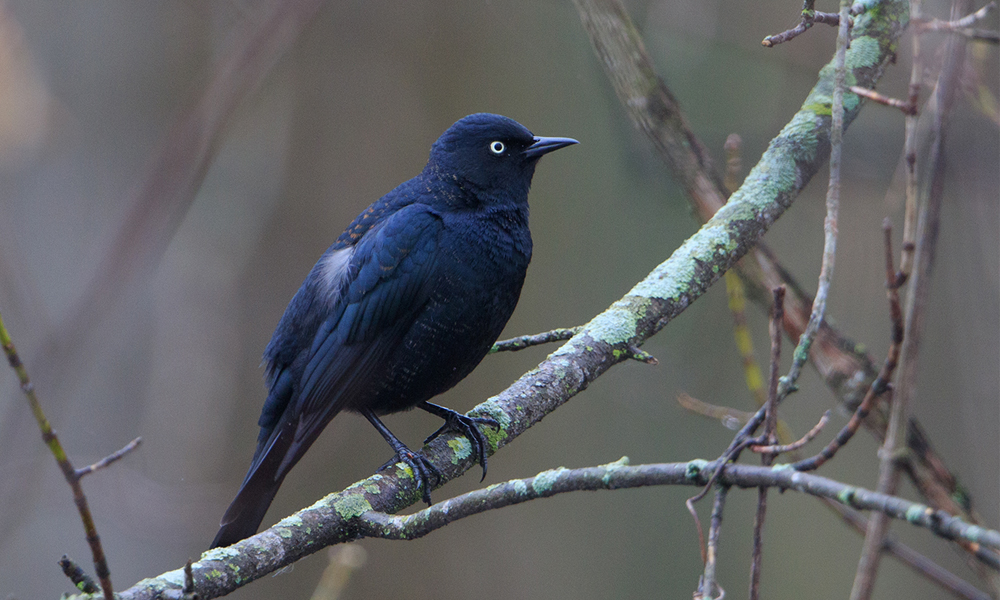
Rusty Blackbird, photo by Judd Patterson
This species gets its name from nonbreeding males’ plumage. Breeding males are a glossy black; nonbreeding males are dark brown with rust-colored edges on their feathers. Their most recognizable song is a creaky chugalasqueeek.
Rusty Blackbirds have seen a precipitous decline in numbers—approaching 90 percent—in recent decades, and despite increased research efforts, scientists haven’t been able to pinpoint the specific cause of this population decline. Habitat loss and fragmentation do seem to be impacting Rusty Blackbirds’ survival.
Conservation Status:
Habitat: In summer, Rusty Blackbirds generally use wet coniferous and mixed forests, and frequent fens, bogs, muskeg, conifer swamps, beaver ponds, and swampy shores along lakes and streams.
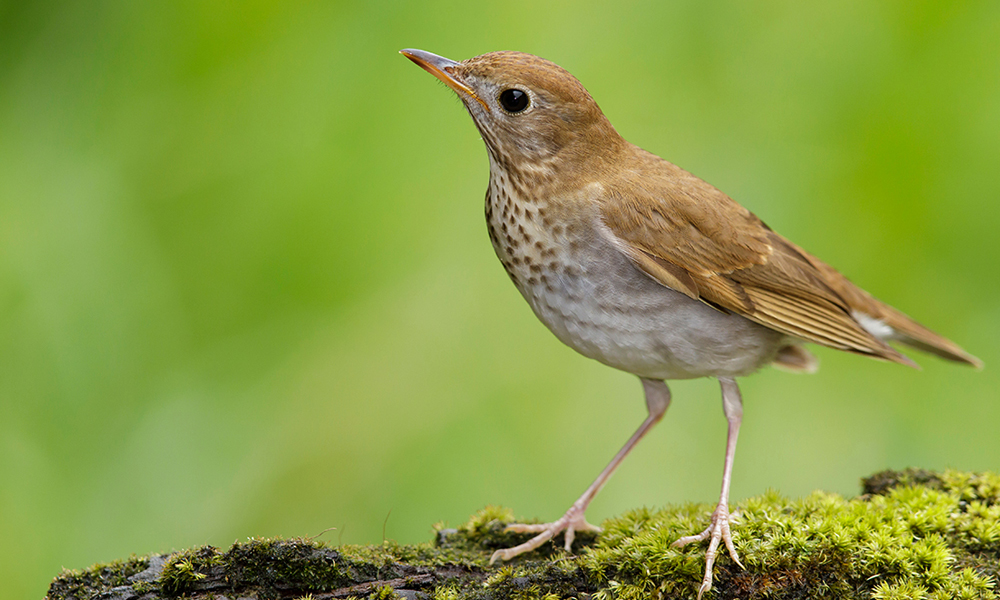
Veery
This thrush’s name comes from the series of veer notes that composes its call, and its song is an ethereal, descending spiral of flutelike notes created through its unique divided syrinx—it sings two notes at a time in a duet with itself. It’s well adapted to moving around on leafy forest floors in search of food, and can work its way from ants, spiders, and flies all the way up to the occasional small frog and salamander.
Conservation Status: Species of Greatest Conservation Need in Maine, High Priority
Habitat: Veery typically inhabit moist hardwood or mixed woods with intermediate canopy cover and a dense understory. They prefer dense areas of early hardwood second growth and are frequently found in riparian areas, regenerating forests, wooded swamps and damp ravines.
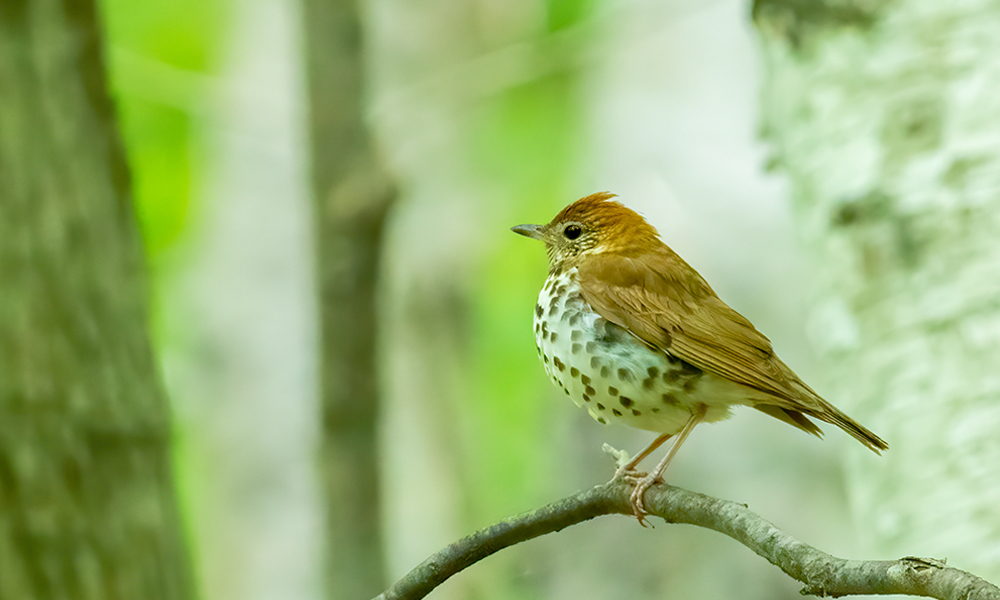
Wood Thrush
Every bird on this list eats insects, but the Wood Thrush and the above Veery are the best camouflaged of them all when it comes to rustling through leaf litter for bugs. The Wood Thrush forages for beetles, caterpillars, spiders, millipedes and other such delicacies. The Wood Thrush is known for an ee-oh-lay song.
Conservation Status: Species of Greatest Conservation Need in Maine, Highest Priority
Habitat: Mature interior forest stands of moist hardwood or mixed forest with closed canopies greater than 50 feet high. Optimal conditions include a diversity of hardwood tree species, a shrub sub-canopy layer with moderate density, and a fairly open floor.
Creating the right habitat types on our lands will provide crucial support to these birds, but if we want to ensure they thrive, NEFF also needs to address the systemic issues that threaten songbirds in the first place. For example, these 10 priority species all eat bugs, and the biodiversity crisis has hit insects hard.
So, how is NEFF making a big-picture difference? Our Exemplary Forestry standards are designed to work in balance with ecological reserves and to meet diverse habitat needs at a landscape scale, and they improve forest biodiversity while simultaneously mitigating climate change and producing more sustainable wood. We have plans to take these benefits region-wide: Over the next 30 years, NEFF will work to significantly expand the use of Exemplary Forestry across the managed portion of New England’s 32 million forestland acres as part of our 30 Percent Solution.
Here’s to a future full of birdsong.
Free technical assistance and funding for forest management plans with a focus on fish, bird, and wildlife habitat restoration and climate adaptation is available to family and other non-commercial landowners with more than 75 acres of forest through a partnership with the Natural Resources Conservation Service. Land must be located in Oxford, Franklin, Somerset, and Piscataquis counties. Project participation is based on a free assessment of how a property can contribute to improving habitat across the greater landscape. Learn more.
Maine Audubon provides a forestry guide and other resources to landowners who have the potential to create high-quality bird habitat on their woodlands. Details: maineaudubon.org/projects/forestry-for-maine-birds